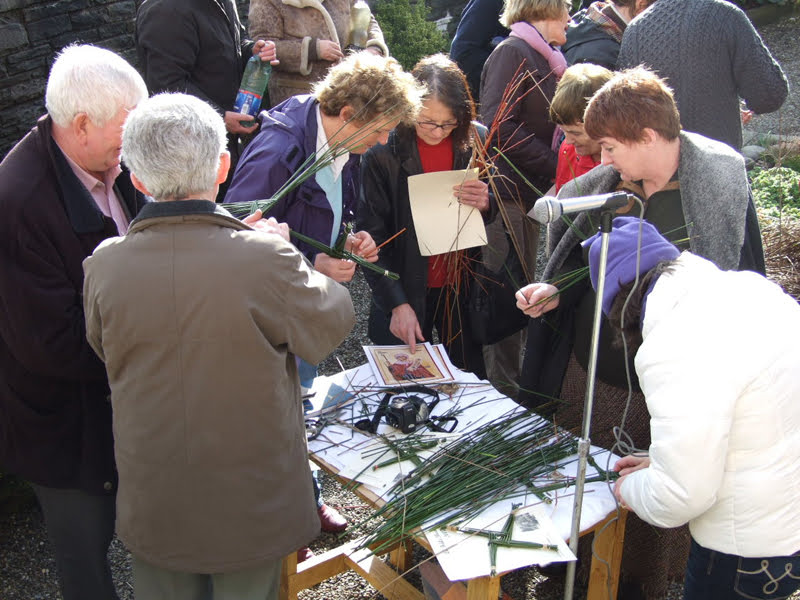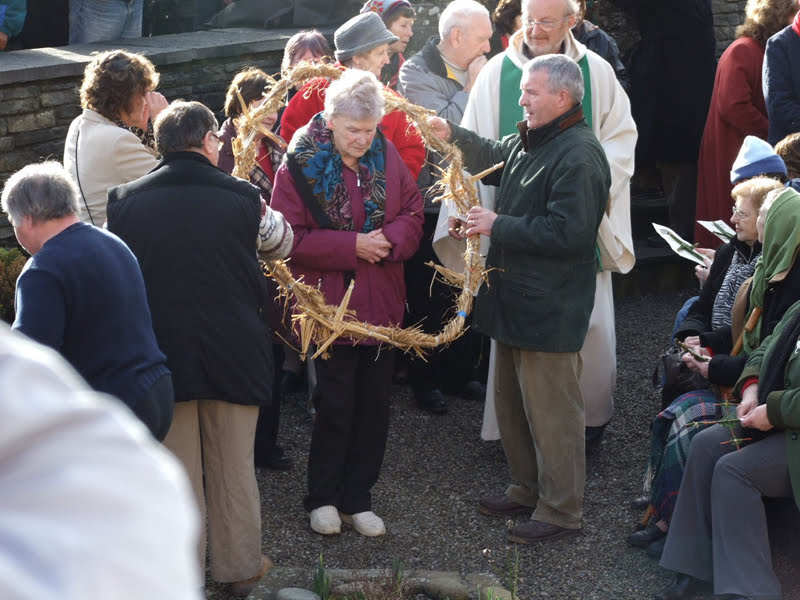St. Brigid's Crosses and Girdles

St. Brigid's crosses consist of rushes woven into a swastica-like ornament, reminiscent of a number of designs found in Celtic art both ancient and modern. In their construction they are very much like the whirligigs found on painted pottery or the swasticas in the few textiles that exist from Celtic burial sites. A typical cross consists of a central square with four spokes, one protruding from each corner of the square in an opposing direction. Crosses of this type are found in Ireland to this day although the feast day customs with which they were associated mostly died out in the 19th century.
On the eve of St. Brigid's Feast, (February 1, the Celtic feast of Imbolc, for renewal and purification) traditionally, young boys called brideoga or biddies would carry a churndash (the post used for churning butter) dressed as a woman, with an effigy of St. Brigid, and ask door to door for gifts or alms. O Cathasaigh notes that the churndash is symbolic of milking which has relevance both to the saint, who attended to a dairy, and to the festival of Imbolc. In addition to begging for alms, the brideoga would leave bundles of straw and rushes outside the doors at homes. At nightfall young girls would pick them up, and, after asking to be admitted in the name of the saint, would weave them into crosses. After traditional prayers and a meal, crosses would then be placed under the eaves in the house or in outhouses. Before they were placed in the thatch, however, the crosses would sometimes be blessed with holy water, a ritual with connotations simultaneously Christian and Pagan.
Leftover materials from the making of crosses were also used in a ritualized manner. They would often be woven into a girdle called a crios, ties for cattle, and sometimes into a mattress for the saint. Just as cattle were traditionally led through holy lakes or doused in water from Brigid's well, they were often led through the uplifted arches of these girdles. The creation of a mattress for the saint also finds its parallel in folk traditions associated with holy wells. At certain wells, Cruach Patrick in particular, there are flat rocks in the shape of a bed or mattress that supposedly pilgrims could lay upon to counter infertility or to assure an easy birth. These crafts of Brigid's feast day were not only believed to have curative powers and to counter barrenness, but to protect the family and animals from natural calamities, especially lighting and fire. In the Tuatha de Danaan, Brigid (Brid, Brede, Brigit, etc.) is a life-giving goddess but is also attributed with fire, both in its destructive uses and in metalwork.
These crosses allude in so many ways to the questionable status of Brigid's Christian origins. Most obvious are the links to cattle, life-giving, and death, although the design itself may suggest vestiges of solar-symbolism. There seems to be little argument among scholars that even if an actual holy woman named Brigid existed, in fact over fifteen were recorded , that her life and miracles are Christian revisions of pre-established beliefs. There are too many coincidences in the life of the saint, the mythology of the goddess, and strangely similar festivals to believe otherwise.
Most of what we know about St. Brigid — known as the "Mary of the Gael" — comes from medieval biographies of the saints. It is believed that she was converted by St. Patrick and after his death founded a monastery in Kildare around the year A.D. 500. Brigid comes across as an extraordinarily strong and self-reliant woman - very much like the Medb of Celtic legend - and some accounts say she was ordained a bishop and celebrated Mass.

